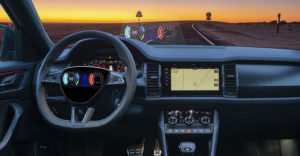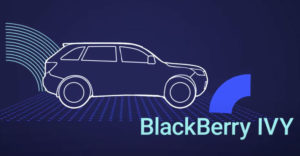Last week was BlackBerry’s annual analyst summit. Since BlackBerry’s tools and QNX operating system are expected to be heavily used in the next generation of cars, this event often provides a view into the future of automobiles. That future is coming very quickly, and it promises to change most everything we currently define as an automobile, from who drives it, to how it behaves while you own it. These changes are also expected to dramatically reduce automobile ownership by individuals.
These future cars will increasingly be like computers with wheels on them. They’ll have more computational power than the supercomputers of a few years back, be wrapped with services, and come preloaded with accessories that you can enable later. The only thing these cars will have in common with the cars of today is their appearance, and even that isn’t a sure thing. Some of the proposed designs look like rolling living rooms, while others fly.
Let’s talk about the software-defined vehicles (SDVs) that will come to market in only three to four short years. Then we’ll close with my product of the week, also from BlackBerry, that is perfect for today’s conflicted and changing world. It’s something that every company and country should have implemented by now — and is critical to the pandemic and hybrid work world we currently live in.
Carmakers’ Troubled Journey to the SDV
Software-defined vehicles have been slowly making their way to market over the last two decades and it hasn’t been pretty. This future car concept, as I noted above, is basically a supercomputer with wheels able to navigate on, and sometimes off, road as needed autonomously, often far better than a human driver can perform.
I first looked into SDVs back in the early 2000s when I was invited to visit GM’s OnStar effort which was having significant operational difficulties. The issues were that OnStar management wasn’t from the computing industry — and while they hired computing experts, GM wouldn’t listen to them. The result was remaking a long list of mistakes the computer industry had made and learned from over the prior decades.
Later, the car companies resisted vehicle-to-vehicle (V2V) technology because they didn’t want competing vehicles talking to each other. They thought that if they (who were not software experts) created an autonomous driving platform, their competitors would license it from them (something that was never going to happen). In effect, early on, GM was hardly an outlier in its proprietary approach to the problem and its lack of confidence in the software experts it hired to fix it.
This is one of the reasons Tesla blew by the much larger and better funded existing car companies. Tesla used the knowledge of the technology industry to create a superior rolling computer. While Tesla’s competitors tried to recreate what was already known by the computing industry, Tesla was selling cars and dominating the electric car segment.
As time went by, this proprietary approach waned in popularity. The car companies realized they were decades away from matching Tesla and began to pivot toward partnering with technology companies who knew how to build a computing platform better.
Anticipated Birth of the SDV
Over time and surprisingly slowly, the automotive OEMs began to adopt technology from the computing industry. Nvidia has been massively successful here as most carmakers are now using its Omniverse-based simulation platform to develop its software. Because initially it is the far least risky approach, some are also planning to use Nvidia’s hardware, at least initially, to avoid the likely liability and potential recalls that will result from using a hardware platform that was not part of the complete Nvidia solution.
On the software side, BlackBerry has supplied its QNX OS which was developed to meet very high military and infrastructure needs (think nuclear power plants) specifically focused on security. You want the OS on your car to be very secure because no one wants to be taking a nap in the back of their car when it gets hacked and suddenly thinks it is in a demolition derby.
This combination of technologies allows car companies to rethink how they deliver automobiles. Up until now, for most modern cars, you get what you order. If you want something changed, you deal with that in the aftermarket. But car companies have realized they can build features into the cars that can later be turned on because of subscriptions. In turn, this can extend the revenue potential for their products beyond the initial sale and provide instant gratification for their users.
Much like you can run a variety of apps and games on your phone, you’ll be able to progressively do the same with your car. But with these capabilities comes equivalent risks that the car could become compromised and do bad things, and since we are talking about a fast-moving, heavy, high-velocity vehicle, those “bad things” could turn out to be a brand killer if enough hacks happen in a very narrow window.
BlackBerry shared that the combination of moving to SDV coupled with the use of BlackBerry technologies like QNX and IVY (which I’ve talked about before) are helping carmakers make this software-defined transition safely and securely so we aren’t worried that, instead of taking us for a drive, our cars will instead be taking us for a ride.
Wrapping Up: Anticipating Tomorrow’s Cars
The cars that show up mid-decade, in just three short years, will be vastly different than the fixed products we have today. They’ll be software upgradeable, more secure, more autonomous, and some will even fly. To get there, car companies have, with some exceptions, moved to adopt and use technology from companies like IBM, Nvidia and BlackBerry.
When cars can pick you up and don’t need drivers, there is an argument that we’ll no longer own cars but pay for a service. Yet even before that becomes common, our cars will become software-defined, which means they’ll be upgradable over the air — including the addition of features you didn’t initially order but later discovered you wanted, and they’ll be increasingly able to drive themselves.
Assuring the result is secure is critical to both our lives as drivers and pedestrians, but also to minimize OEM liability and maximize OEM revenues while reducing automotive churn and keeping more cars out of landfills.
The automotive world will change a lot in the second half of the decade and look very different than it does today.

BlackBerry AtHoc
As I’ve been watching the war in Ukraine, one BlackBerry product jumped out at me that should be far more widely used, which is AtHoc.
AtHoc is an employee tracking and care application designed to help employees in a disaster both by letting their managers know what their condition is, and keeping the employees informed regarding dangers and how to safely deal with them.
Many may remember that during the 9/11 attack, BlackBerry pagers remained in operation even after the telephone infrastructure failed, allowing first responders to receive critical information about the nature of the disaster and where they needed to go to mitigate it.
We don’t have those pagers anymore. Instead, we have AtHoc which, in times of disaster, helps match an employee at risk with the resources and information they need to significantly reduce that risk and get to safety.
Sadly, according to John Chen, BlackBerry’s CEO, it isn’t yet used in Ukraine but has been used successfully to protect employees during other military attacks and has performed in an exemplary fashion. It has also been very helpful during the pandemic by keeping track of infections with employees, allowing for better backfilling, and helping to assure the infected employee gets the resources they need to get better.
Currently, AtHoc is aggressively used by government (including public safety and law enforcement) and education. But, I think, given the risks we are facing, it should be far more widely implemented to better assure that an employee in distress gets the help they need soon enough to ensure their safety and health.
AtHoc may be the best product in the market focused on employee safety, and we need that focus these days. So, Blackberry AtHoc is again my product of the week.



























































